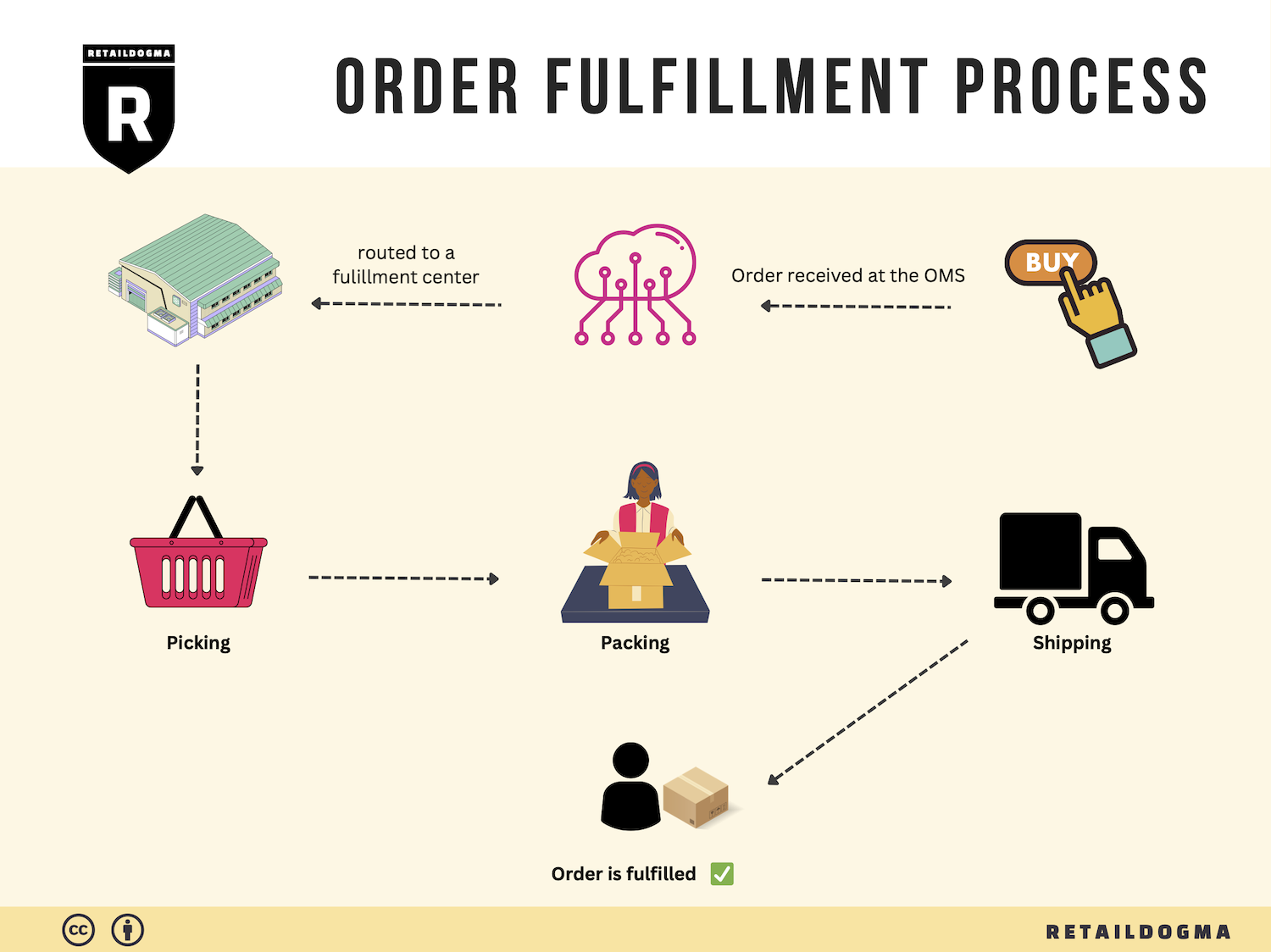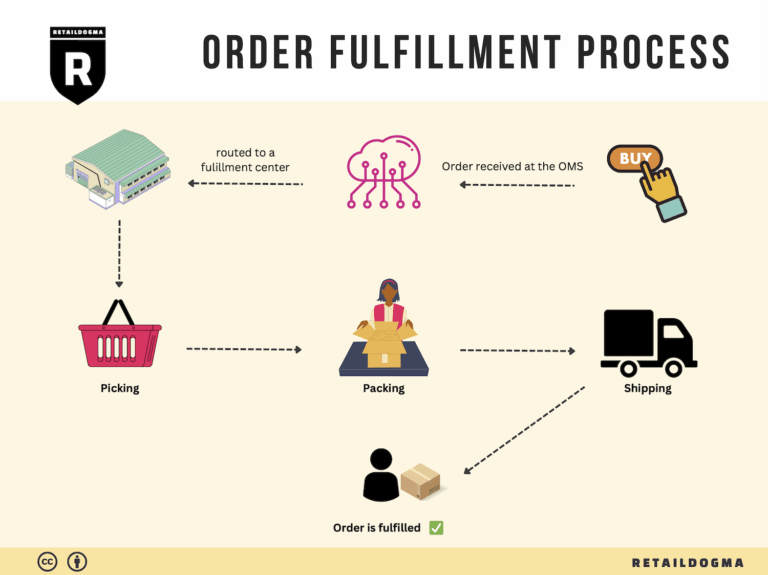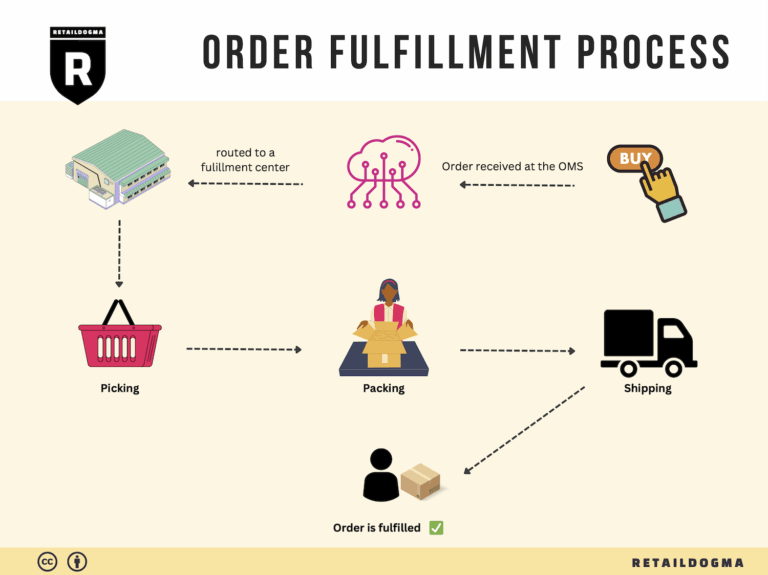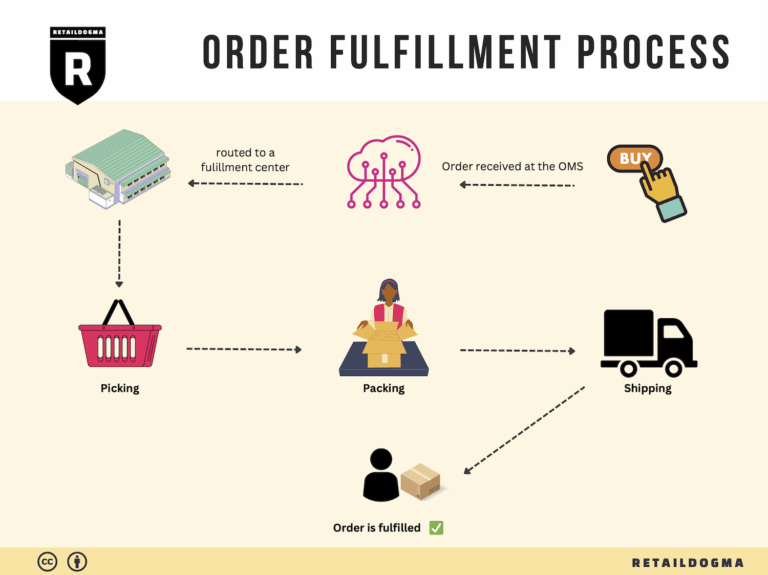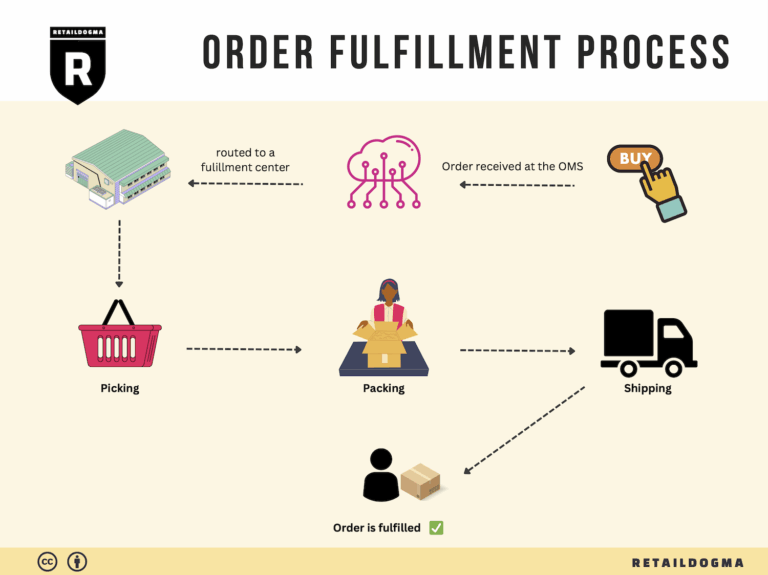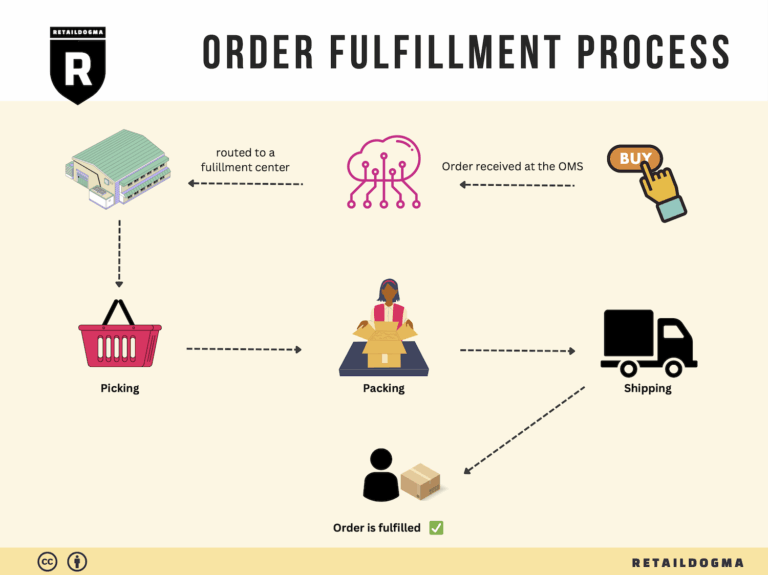How Order Fulfillment Works: A Step-by-Step Guide for Businesses
What is E-commerce Fulfillment? An Introduction for Growing Businesses
Understanding E-commerce Fulfillment: A Critical Component for Growth
As an e-commerce business owner, you may find yourself overwhelmed with the intricacies of packing and shipping orders. The excitement of growing sales can quickly turn into a logistical nightmare, where the demands of fulfillment overshadow your focus on scaling your business. This is where understanding e-commerce fulfillment becomes crucial. Simply put, fulfillment is the process of getting a product from your inventory to your customer’s doorstep. It involves a series of steps, including inventory management, order processing, packing, shipping, and handling returns.
Navigating the world of fulfillment can be daunting, especially when considering the various models available. In this guide, we will explore the most common fulfillment strategies that can help streamline your operations. You may have heard of Third-Party Logistics (3PL) providers, which allow you to outsource your warehousing and shipping needs, or Fulfillment by Amazon (FBA), a service that lets you leverage Amazon’s vast logistics network to fulfill your orders. Each model comes with its own set of advantages and challenges, and understanding these can help you make informed decisions.
Additionally, we will cover the core services that fulfillment partners typically offer. These may include inventory storage, order processing, pick-and-pack services, shipping logistics, and customer service support. Knowing what to expect can help you assess potential partners effectively.
Choosing the right fulfillment partner is a critical decision that can significantly impact your operational efficiency and customer satisfaction. This guide will provide insights into evaluating potential partners, including factors such as location, technology capabilities, scalability, and customer reviews.
Pricing is another vital aspect that will be discussed in detail. Understanding the cost structures associated with different fulfillment models will empower you to budget effectively and choose a solution that aligns with your financial goals.
Ultimately, the goal of this guide is to empower e-commerce businesses like yours to make smart logistics decisions. By demystifying the fulfillment process and providing practical insights, we aim to equip you with the knowledge needed to optimize your operations and focus on what you do best: growing your business. Whether you’re just starting out or looking to scale, effective fulfillment strategies can enhance your customer experience and support your long-term success.
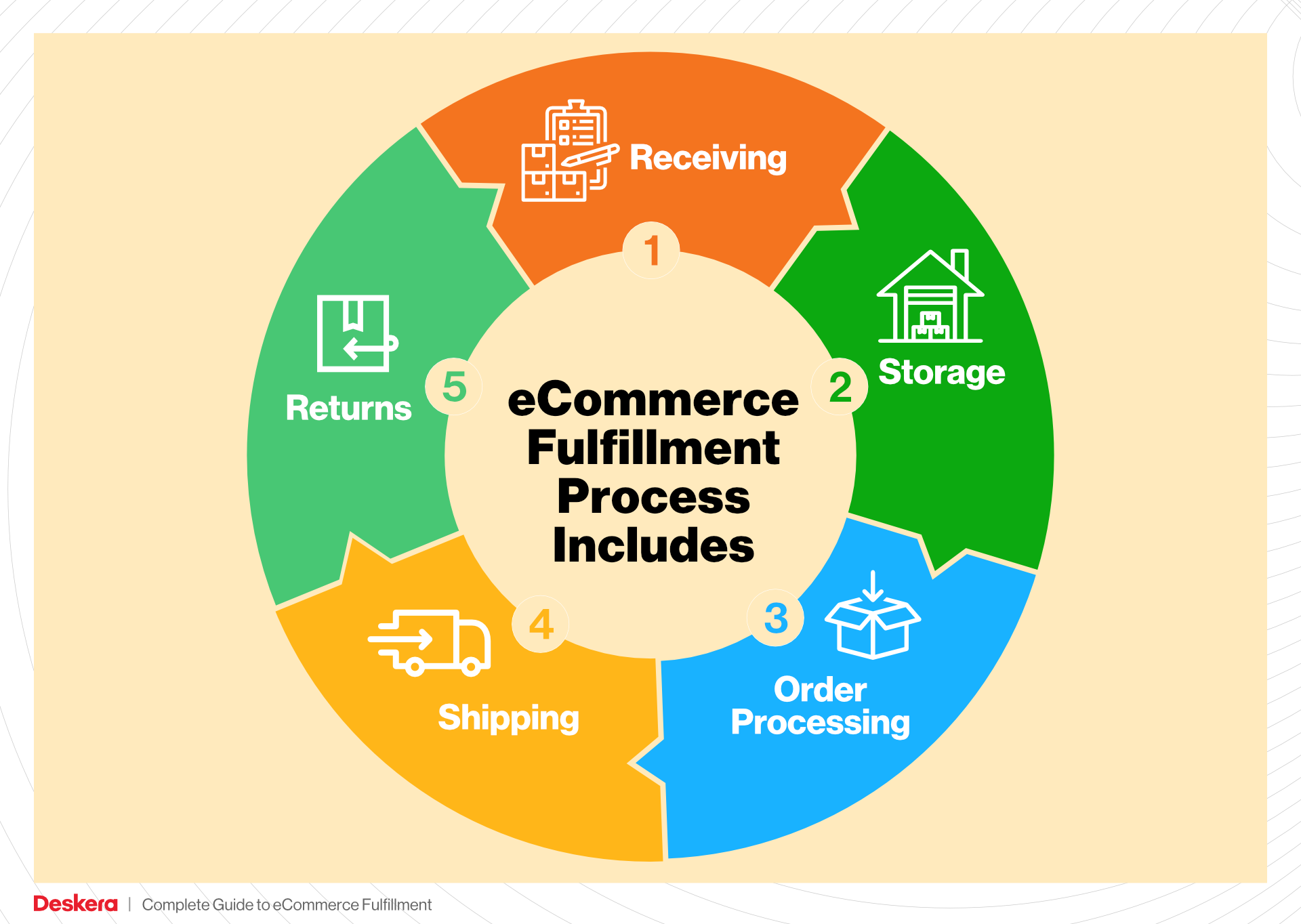
What You’ll Learn In This Guide
- What is E-commerce Fulfillment? An Introduction for Growing Businesses
- The Order Fulfillment Process: From ‘Buy’ Button to Customer’s Door
- Comparing Fulfillment Models: In-House vs. 3PL vs. Dropshipping
- A Deep Dive into Amazon FBA: Pros, Cons, and Who It’s For
- Core Services Offered by Fulfillment Centers
- How to Choose a Fulfillment Partner: A 6-Point Checklist
- Understanding Fulfillment Pricing: A Breakdown of Common Fees
- Frequently Asked Questions (FAQs) about Fulfillment
- Conclusion: Is Outsourcing Fulfillment the Right Move for Your Business?
- Important Disclaimer
The Order Fulfillment Process: From ‘Buy’ Button to Customer’s Door
1. Receiving Inventory
The order fulfillment process begins with receiving inventory from suppliers. This step involves checking the delivered goods against the purchase orders to ensure accuracy and quality. Key activities include inspecting for damages, verifying quantities, and recording information into the inventory management system.
Importance: Proper receiving procedures are crucial for maintaining accurate inventory levels and preventing stock discrepancies. This step sets the foundation for effective inventory management and ensures that the products available for sale are in good condition.
Key Term: SKU (Stock Keeping Unit) – A unique identifier assigned to each product that helps track inventory levels, manage stock, and facilitate efficient order processing.
2. Warehouse Storage
Once inventory is received, it is moved to designated storage locations within the warehouse. This involves organizing products in a way that optimizes space and accessibility. Efficient storage practices may include categorizing items by type, size, or demand frequency to streamline future picking processes.
Importance: Effective warehouse storage maximizes space utilization and reduces the time taken to retrieve items for orders. A well-organized warehouse minimizes clutter, enhances safety, and ultimately contributes to faster order fulfillment.
Key Term: Location Code – A systematic labeling method used to identify where specific items are stored within the warehouse, facilitating easier navigation and inventory management.
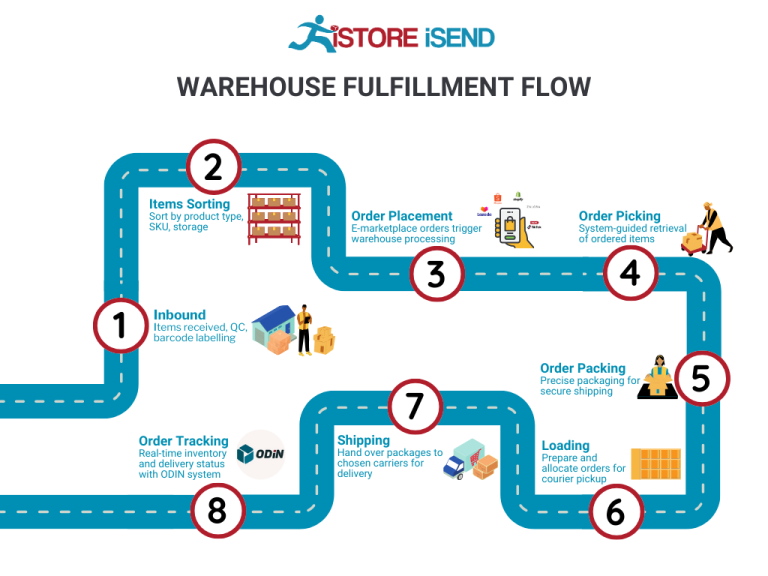
3. Order Picking
When a customer places an order, the next step is order picking, where warehouse staff or automated systems retrieve the necessary items from storage. This process often utilizes pick lists—documents or digital systems that outline the items and quantities to be collected.
Importance: Efficient order picking is critical to meeting customer expectations for delivery speed and accuracy. Reducing the time spent picking items directly impacts the overall fulfillment cycle and enhances customer satisfaction.
Key Term: Pick Lists – Lists generated for warehouse personnel that specify which items to retrieve for a particular order, including their storage locations and quantities.
4. Order Packing
After picking, the items are taken to the packing station, where they are prepared for shipment. This step includes checking the order for completeness, selecting appropriate packaging materials, and labeling the packages with shipping information.
Importance: Proper packing is essential to protect products during transit and ensure they arrive in perfect condition. It also involves compliance with shipping regulations and can influence shipping costs based on weight and dimensions.
Key Term: Packing Slip – A document included with a shipment that itemizes the products included in the package, serving as a confirmation for both the sender and the recipient.
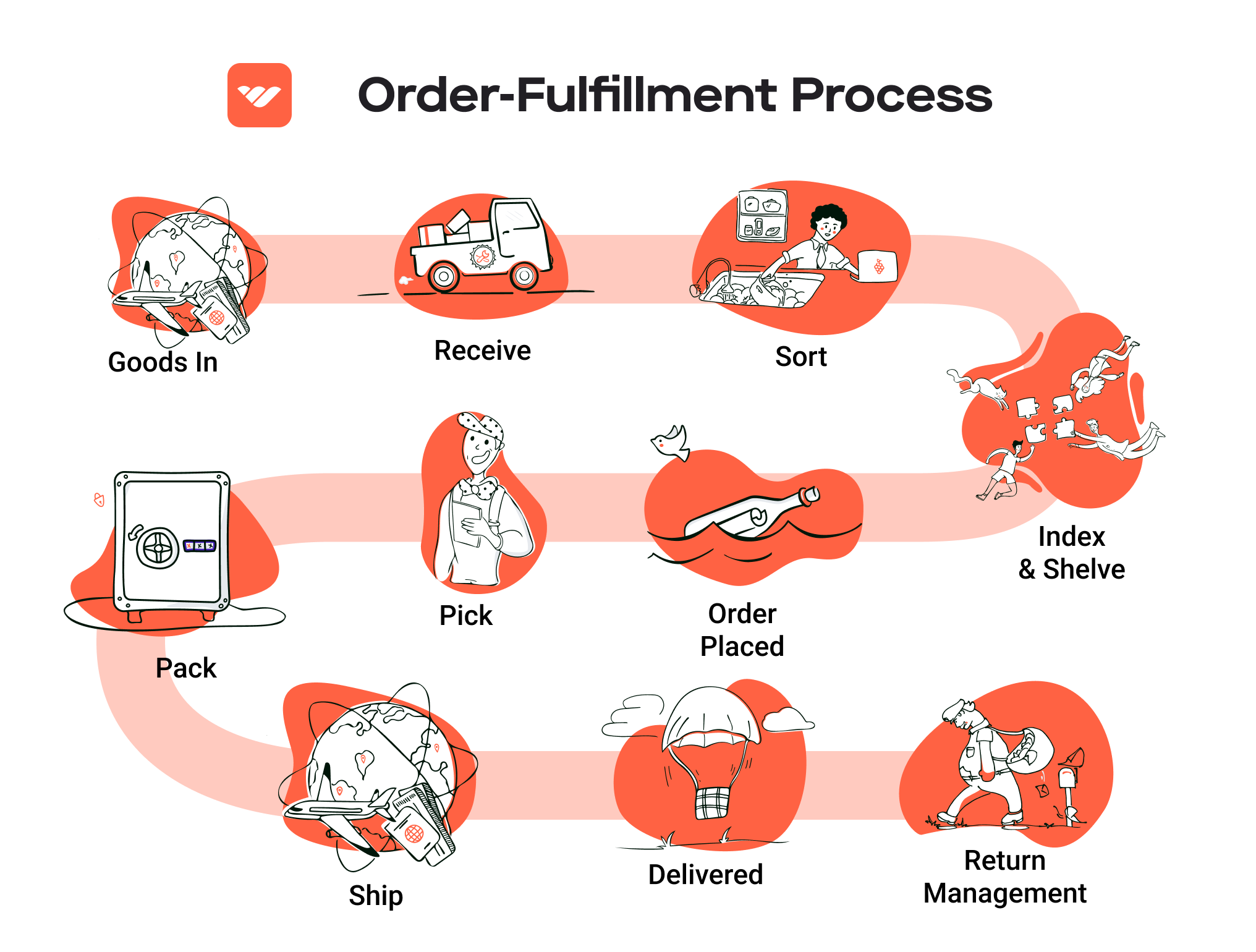
5. Shipping & Delivery
The final step in the order fulfillment process is shipping and delivery. This involves handing off the packed orders to shipping carriers for transport to the customer’s address. Businesses often provide tracking information to customers, allowing them to monitor the status of their shipments.
Importance: Timely shipping and accurate delivery are paramount in the e-commerce landscape. They not only fulfill customer expectations but also enhance brand reputation and loyalty. Efficient logistics strategies can significantly reduce delivery times and costs.
Key Term: Last-Mile Delivery – The final step of the delivery process, where the package is transported from a distribution center to the end customer. This stage is often the most critical and costly, as it directly affects customer experience.
By understanding and optimizing each of these steps in the order fulfillment process, e-commerce businesses can enhance operational efficiency, reduce costs, and improve customer satisfaction. This structured approach is vital for scaling operations and maintaining competitiveness in the ever-evolving e-commerce landscape.
Comparing Fulfillment Models: In-House vs. 3PL vs. Dropshipping
Fulfillment Model Comparison
| Model | Who Handles Inventory | Best For (Business Stage) | Key Advantage | Key Disadvantage |
|---|---|---|---|---|
| In-House Fulfillment | Business itself | Established businesses | Full control over inventory and operations | High overhead costs and resource requirements |
| Third-Party Logistics (3PL) | Third-party logistics provider | Growing businesses | Scalable and flexible logistics solutions | Less control over operations and potential service variability |
| Dropshipping | Supplier or manufacturer | Startups and small businesses | Low upfront investment and no inventory holding | Lower profit margins and reliance on supplier reliability |
In-House Fulfillment
In-house fulfillment refers to a model where the business manages all aspects of storage, inventory management, order processing, and shipping. This approach is ideal for established businesses that have the resources to invest in warehouse space, staff, and technology. One of the primary advantages of in-house fulfillment is the complete control it offers over inventory and operations. Businesses can customize their processes to meet specific customer needs, maintain quality control, and ensure brand consistency. However, the key disadvantage is the significant overhead costs associated with running a fulfillment operation. This includes warehousing expenses, labor costs, and the investment in technology and systems to manage logistics effectively. As a business scales, these costs can become burdensome, making it essential to evaluate whether the benefits of in-house fulfillment outweigh the financial implications.
Third-Party Logistics (3PL)
Third-party logistics (3PL) providers offer businesses a flexible and scalable solution for managing their logistics needs. In this model, a business outsources its warehousing, inventory management, and shipping to a specialized logistics partner. This is particularly beneficial for growing businesses that may not have the infrastructure or capital to invest in their own fulfillment centers. The key advantage of using a 3PL is the ability to scale operations quickly without the need for significant capital investment. 3PL providers typically have established networks and systems in place to streamline logistics, which can lead to faster shipping times and improved customer satisfaction. However, the downside is that businesses may experience less control over their operations, as they depend on the 3PL to handle key logistics functions. Additionally, the variability in service quality and potential misalignment with brand values can pose challenges, making it crucial to choose a reputable and reliable 3PL partner.
Dropshipping
Dropshipping is a fulfillment model where the retailer does not keep products in stock. Instead, when a customer places an order, the retailer purchases the item from a third-party supplier who ships it directly to the customer. This model is particularly attractive for startups and small businesses due to its low upfront investment and reduced risk. Retailers can offer a wide range of products without the burden of managing inventory or warehousing. The key advantage of dropshipping is that it allows entrepreneurs to focus on marketing and sales rather than logistics. However, dropshipping also comes with its own set of challenges. Profit margins can be lower compared to traditional retail models, as retailers often pay a premium for the convenience of not holding inventory. Moreover, businesses rely heavily on suppliers for product quality and shipping reliability, which can lead to customer dissatisfaction if issues arise. As a result, it is vital for businesses using this model to carefully vet suppliers and establish clear communication channels to ensure a smooth fulfillment process.
Conclusion
Choosing the right fulfillment model is a critical decision for e-commerce businesses looking to scale. Each model—In-House Fulfillment, Third-Party Logistics (3PL), and Dropshipping—offers distinct advantages and disadvantages that align differently with various business stages and needs. Business owners must evaluate their operational capabilities, financial resources, and growth plans to select the most suitable fulfillment strategy. By understanding the implications of each model, entrepreneurs can make informed decisions that enhance their logistics efficiency and customer satisfaction.
A Deep Dive into Amazon FBA: Pros, Cons, and Who It’s For
Understanding Fulfillment by Amazon (FBA)
Fulfillment by Amazon (FBA) is a service offered by Amazon that allows e-commerce sellers to store their products in Amazon’s fulfillment centers. Amazon then takes care of storage, packaging, and shipping of these products directly to customers. This service has become increasingly popular among sellers who wish to leverage Amazon’s vast logistics network, customer service, and reach without having to manage these aspects on their own.
How FBA Works
-
Product Listing: Sellers first list their products on Amazon. When a customer orders a product, the seller’s inventory in an Amazon fulfillment center is automatically identified.
-
Shipping to Amazon: Sellers send their products to one or more of Amazon’s fulfillment centers. This can include a range of products from small household items to larger goods.
-
Storage: Amazon stores the seller’s products in their warehouses. The seller is charged fees based on the amount of space their products occupy and the duration of storage.
-
Order Processing: When a customer places an order, Amazon picks, packs, and ships the product on behalf of the seller. They also handle customer service and returns.
-
Customer Delivery: Products are shipped using Amazon’s logistics network, often resulting in faster delivery times, including eligibility for Amazon Prime two-day shipping.
-
Payment: After the sale, Amazon collects payment from the customer, deducts its fees, and then remits the remainder to the seller.
Pros of Using FBA
-
Prime Eligibility: Products fulfilled by Amazon are eligible for Amazon Prime, which significantly increases the visibility and attractiveness of the products to millions of Prime members. This can lead to higher sales and customer loyalty.
-
Customer Trust: Leveraging Amazon’s brand, sellers can benefit from the trust customers have in the platform. Customers often feel more secure purchasing items fulfilled by Amazon due to their return policies and customer service reputation.
-
Multi-Channel Fulfillment: FBA is not limited to sales on Amazon. Sellers can use FBA to fulfill orders from other sales channels such as their own website, eBay, or other marketplaces, allowing for streamlined logistics management.
-
Scalability: FBA allows sellers to scale their business without the need for additional warehousing or logistics infrastructure. As sales grow, Amazon can handle increased order volumes without the seller needing to invest heavily in storage or shipping capabilities.
-
Time Savings: FBA can save sellers considerable time by outsourcing logistics, allowing them to focus on other areas of their business, such as marketing and product development.
Cons of Using FBA
-
High Fees: FBA can be expensive. Sellers incur several fees, including storage fees and fulfillment fees, which can add up, especially for low-margin products. This requires careful pricing strategies to maintain profitability.
-
Strict Inventory Rules: Amazon has stringent inventory management policies. Sellers must adhere to guidelines regarding inventory limits, restocking procedures, and product condition. Failure to comply can result in penalties or additional fees.
-
Commingling Risks: FBA uses a commingled inventory system, meaning that your inventory may be stored alongside other sellers’ products. This can lead to complications, such as receiving returns for items that were not yours or being held responsible for damaged or lost goods.
-
Less Control Over Fulfillment: By using FBA, sellers relinquish some control over the fulfillment process. Any issues with shipping, packaging, or customer service are handled by Amazon, which may not always align with the seller’s brand standards.
-
Dependency on Amazon: Relying heavily on FBA can create a dependency on Amazon, making sellers vulnerable to changes in Amazon’s policies, fees, or overall marketplace dynamics.
Who is FBA Best For?
Fulfillment by Amazon is particularly well-suited for:
-
Small to Medium-Sized Businesses: Businesses that may not have the infrastructure or resources to handle their own warehousing and fulfillment can benefit significantly from FBA.
-
New Sellers: Entrepreneurs just starting in e-commerce can leverage FBA to gain a foothold in the competitive online marketplace without the overhead costs associated with logistics.
-
Brands with Established Products: Sellers with proven products that can benefit from Prime eligibility and Amazon’s customer trust will find FBA to be a valuable asset.
-
Seasonal Sellers: For businesses that experience seasonal spikes in sales, FBA can provide a flexible solution for handling increased order volumes without long-term commitments.
-
Multi-Channel Sellers: Sellers who operate on multiple sales channels can use FBA to streamline their fulfillment process, making it easier to manage inventory across different platforms.
In summary, FBA can be a powerful tool for e-commerce sellers looking to scale their operations, provided they understand the associated costs and requirements. By leveraging Amazon’s fulfillment capabilities, sellers can focus on growth and customer engagement while ensuring efficient order processing and delivery.
Core Services Offered by Fulfillment Centers
Inventory Management & Warehousing
Effective inventory management and warehousing are foundational services provided by fulfillment centers. These facilities utilize advanced technology and systematic processes to track, store, and manage stock levels, ensuring that products are readily available to meet customer demands.
What It Is:
Fulfillment centers maintain extensive warehouses equipped with inventory management systems that monitor stock levels in real-time. This includes managing various SKUs (stock-keeping units), organizing products in a manner that maximizes space efficiency, and ensuring proper conditions for different types of goods.
Benefits for E-commerce Businesses:
1. Reduced Overhead Costs: By outsourcing inventory management to a fulfillment center, e-commerce businesses can save on costs associated with maintaining their own warehouses, including rent, utilities, and staffing.
2. Improved Cash Flow: Efficient inventory management prevents overstocking and stockouts, allowing businesses to invest their capital in other growth areas rather than tying it up in excess inventory.
3. Scalability: As a business grows, fulfillment centers can easily accommodate increased inventory levels and product variety without the need for significant capital investment in physical space or infrastructure.
Pick and Pack Services
Pick and pack services are crucial for streamlining order fulfillment processes in e-commerce. This service involves selecting products from the warehouse (picking) and then packaging them for shipment (packing).
What It Is:
When an order is placed, fulfillment center staff or automated systems retrieve the specified items from inventory. Once gathered, these products are carefully packaged to ensure they reach the customer in perfect condition. This process often includes labeling, bundling, and preparing items for shipment.
Benefits for E-commerce Businesses:
1. Efficiency and Speed: Fulfillment centers utilize optimized workflows and technology to minimize order processing time, ensuring that customers receive their orders quickly. This is particularly important in the competitive e-commerce landscape where delivery speed can influence customer satisfaction.
2. Accuracy: Automated systems and trained personnel help reduce picking errors, ensuring that customers receive the correct items. This accuracy can enhance brand reputation and reduce costs associated with returns and replacements.
3. Order Customization: Many fulfillment centers offer customizable packing options, allowing businesses to create a unique unboxing experience that can enhance customer loyalty and encourage repeat purchases.
Kitting and Assembly
Kitting and assembly services enable e-commerce businesses to combine multiple products into a single package or create customized sets tailored to specific customer needs.
What It Is:
This service involves assembling products into kits or bundles before they are shipped. For example, a fulfillment center might package a set of kitchen utensils together or create a promotional bundle that includes multiple related items.
Benefits for E-commerce Businesses:
1. Enhanced Product Offerings: Kitting allows businesses to offer unique product combinations that can attract more customers and differentiate their offerings in a crowded market.
2. Streamlined Shipping: By bundling products together, businesses can reduce shipping costs and simplify logistics. Fewer packages mean less handling and potentially lower shipping rates.
3. Inventory Control: Kitting can help manage inventory more effectively by reducing the number of individual SKUs that need to be tracked, leading to better organization and easier stock management.
Returns Management (Reverse Logistics)
Returns management, or reverse logistics, is a critical service provided by fulfillment centers that addresses the challenges of product returns and exchanges.
What It Is:
This service involves processing returned items, assessing their condition, and determining the appropriate next steps, whether that be restocking, refurbishing, or disposal. Fulfillment centers handle all aspects of returns, from customer service interactions to inventory updates.
Benefits for E-commerce Businesses:
1. Customer Satisfaction: Efficient returns management is vital for maintaining customer satisfaction. A seamless and straightforward return process encourages customers to shop with confidence, knowing they can easily return items if necessary.
2. Cost Management: Properly managing returns can minimize losses associated with returned goods. Fulfillment centers can assess returned items and determine whether they can be resold, repaired, or need to be written off, helping businesses recover value from returns.
3. Data Insights: Returns management provides valuable data on customer preferences and product issues. Analyzing return reasons can help businesses improve product offerings, enhance quality, and refine marketing strategies.
By leveraging these core services, e-commerce businesses can significantly enhance their operational efficiency, improve customer satisfaction, and ultimately drive growth in a competitive marketplace. Fulfillment centers like Amazon MEM3 play a pivotal role in enabling these capabilities, allowing businesses to focus on scaling their sales while leaving logistics in capable hands.
How to Choose a Fulfillment Partner: A 6-Point Checklist
Location & Warehouse Network
Importance: The geographical location of your fulfillment partner can significantly impact shipping times and costs. A partner with multiple warehouse locations allows for optimized shipping routes and faster delivery to your customers.
Questions to Ask:
– Where are your warehouses located, and how do they align with my target markets?
– How many warehouses do you operate, and what is their capacity?
– Can you provide same-day or next-day shipping options, and if so, what are the additional costs?
Technology & Integrations
Importance: A fulfillment partner’s technology capabilities are crucial for seamless order processing and inventory management. Advanced systems can automate many processes, reducing errors and enhancing efficiency.
Questions to Ask:
– What order management system do you use, and how does it integrate with my e-commerce platform (e.g., Shopify, Amazon)?
– Do you provide real-time tracking and inventory updates?
– What technologies do you use to ensure accuracy in order picking and packing?
Specializations (e.g., Cold Storage, Oversized Items)
Importance: Depending on the nature of your products, it may be essential to find a fulfillment partner that specializes in specific areas, such as cold storage for perishable goods or handling oversized items.
Questions to Ask:
– Do you have any special capabilities or certifications for handling my type of products?
– What kind of equipment and facilities do you have for temperature-sensitive items?
– How do you manage unique packaging or handling requirements for oversized products?
Scalability & Capacity
Importance: As your business grows, your fulfillment needs will likely change. It’s vital to choose a partner that can scale with you, whether that involves increasing storage space or adapting to seasonal fluctuations.
Questions to Ask:
– How do you handle increased order volumes during peak seasons?
– What is your process for scaling up capacity if my business grows unexpectedly?
– Can you provide examples of how you’ve managed growth for other clients?
Pricing and Contracts
Importance: Understanding the pricing structure and contract terms is critical to avoid unexpected costs. Transparent pricing can help you maintain your profit margins as you scale.
Questions to Ask:
– What are your pricing models (e.g., per order, per item, monthly fees)?
– Are there any additional fees for services like returns, storage, or special handling?
– What is the length of the contract, and are there penalties for early termination?
Customer Support & Reviews
Importance: Reliable customer support is essential for resolving issues quickly and maintaining a smooth operation. Additionally, checking reviews can provide insight into the partner’s reliability and service quality.
Questions to Ask:
– What customer support options do you provide (e.g., phone, chat, email)?
– How quickly can I expect a response to inquiries or issues?
– Can you provide references or case studies from current clients, and what do reviews say about your services?
Conclusion
Choosing the right fulfillment partner is a critical decision for e-commerce businesses looking to scale. By carefully evaluating potential partners against this checklist, you can ensure that you select a provider that not only meets your current needs but can also grow with your business. This strategic approach to selecting a fulfillment partner will help streamline your operations, enhance customer satisfaction, and ultimately drive sales growth.
Understanding Fulfillment Pricing: A Breakdown of Common Fees
Initial Setup Fees
When partnering with a fulfillment center like Amazon MEM3, businesses may encounter initial setup fees. These fees cover the costs associated with integrating your systems with the fulfillment center’s technology, including inventory management and order processing systems. Initial setup fees can vary widely based on the complexity of your requirements and the fulfillment center’s capabilities. Typically, they range from a few hundred to several thousand dollars.
Calculation: Initial setup fees are usually a one-time charge and can be calculated based on the level of customization needed, the number of products you plan to fulfill, and the integration time required. It is advisable to request a detailed breakdown of these costs before proceeding.
Receiving Fees
Receiving fees are charged when the fulfillment center accepts your inventory. This fee covers the labor and processes involved in unloading, inspecting, and storing your products. The cost can differ depending on the volume of goods received and the complexity of the items (e.g., if they require special handling).
Calculation: Typically, receiving fees are calculated per pallet or per unit. For instance, you might pay a fixed rate for each pallet received, which can range from $15 to $50. If your products are smaller or need individual handling, you might see a per-item charge instead.
Storage Fees (per pallet/bin)
Once your inventory is stored in the fulfillment center, storage fees apply. These fees are charged based on the space your products occupy, typically calculated per pallet or bin. Storage fees can fluctuate based on the time of year; for example, costs may increase during peak seasons like holidays due to higher demand for space.
Calculation: Storage fees are generally charged monthly and can range from $10 to $30 per pallet, depending on the fulfillment center’s location and demand. It is crucial to evaluate your inventory turnover rates to minimize storage costs and ensure you are not paying for excess space.
Pick & Pack Fees (per item/order)
Pick and pack fees are incurred every time an order is processed. This fee includes the costs of picking the items from storage, packing them for shipment, and preparing the order for delivery. The complexity of your products can impact these fees; for instance, items requiring special packaging or additional materials might incur higher charges.
Calculation: Pick and pack fees are typically charged per item or per order. A common structure may involve a base fee for processing an order, plus an additional charge for each item included in that order. Base fees can range from $1 to $5, while per-item fees might range from $0.25 to $1.50. Understanding your average order size and frequency will help you estimate these costs accurately.
Shipping Fees
Shipping fees represent the costs associated with transporting your products to the end customer. These fees can vary significantly based on the shipping method (standard, expedited, etc.), the destination, and the weight and dimensions of the package. Fulfillment centers often negotiate shipping rates with carriers, which can benefit your business.
Calculation: Shipping fees are calculated based on the shipping method chosen and the package specifications. Most fulfillment centers provide a shipping rate calculator that factors in these variables. It’s essential to consider both domestic and international shipping rates if you plan to sell globally, as these can differ considerably.
Tips for Getting an Accurate Quote
-
Clarify Your Needs: Before seeking a quote, clearly outline your fulfillment needs, including the types of products, expected order volumes, and any special handling requirements.
-
Request Detailed Breakdowns: Ask for a detailed breakdown of all potential fees, including any variable costs that may arise based on your business activities.
-
Consider Seasonal Variations: Inquire about how fees may change during peak seasons and if there are any discounts for long-term contracts or higher volumes.
-
Compare Multiple Providers: Don’t settle for the first quote. Compare offers from multiple fulfillment centers to ensure you are getting competitive pricing.
-
Negotiate Terms: Many fulfillment centers are open to negotiation, especially if you bring a substantial amount of business. Don’t hesitate to discuss potential discounts or bundled services.
By understanding these common fulfillment pricing models and following the tips provided, e-commerce business owners can make informed decisions that align with their operational needs and budget constraints, ultimately leading to a more efficient scaling of their logistics operations.
Frequently Asked Questions (FAQs) about Fulfillment
1. What is Amazon Fulfillment Center MEM3?
Amazon Fulfillment Center MEM3 is a state-of-the-art logistics facility located at 1615 Commerce Parkway, Horn Lake, MS. It serves as a key node in Amazon’s vast supply chain network, utilizing advanced technology, including robotics, to efficiently manage the storage, packaging, and shipping of a wide range of products to customers.
2. How does the fulfillment process work at MEM3?
At MEM3, the fulfillment process begins when an order is placed. The facility employs a combination of automated systems and human workers to pick items from inventory, package them securely, and prepare them for shipping. Orders are then dispatched via various transportation methods, ensuring timely delivery to customers.
3. What types of products are processed at MEM3?
The MEM3 fulfillment center handles a diverse array of products, from small everyday items like electronics and household goods to larger merchandise. Its advanced inventory management system allows for efficient organization and rapid processing of various product categories.
4. What is the difference between a warehouse and a fulfillment center?
A warehouse primarily serves as a storage space for goods, focusing on inventory management and distribution. In contrast, a fulfillment center is designed to handle the entire order fulfillment process, including picking, packing, and shipping products directly to customers. Fulfillment centers are typically more operationally complex and technology-driven than traditional warehouses.
5. What is a 3PL (Third-Party Logistics)?
A Third-Party Logistics (3PL) provider is a company that offers outsourced logistics services to businesses. This can include warehousing, order fulfillment, transportation, and distribution. Utilizing a 3PL can help e-commerce businesses scale their operations efficiently by leveraging the provider’s expertise and infrastructure.
6. How much do fulfillment services cost?
The cost of fulfillment services can vary widely based on several factors, including the volume of orders, the types of products being shipped, and the specific services required. Generally, businesses can expect to pay fees related to storage, picking and packing, shipping, and additional services such as returns management. It’s advisable to obtain quotes from multiple fulfillment providers to compare pricing structures.
7. What are the benefits of using Amazon Fulfillment Center MEM3?
Using MEM3 offers several advantages, including access to Amazon’s extensive logistics network, advanced technology that enhances order accuracy and speed, and the ability to scale operations without the need for significant upfront investment in infrastructure. Additionally, utilizing Amazon’s fulfillment services can improve customer satisfaction through faster delivery times.
8. How can I track my orders processed through MEM3?
Amazon provides comprehensive tracking capabilities for orders processed through its fulfillment centers, including MEM3. Customers receive tracking numbers upon shipment, which they can use to monitor their packages in real-time via the Amazon website or app.
9. What are the hours of operation for Amazon Fulfillment Center MEM3?
Amazon Fulfillment Center MEM3 operates 24/7, allowing for continuous processing and shipping of orders. This around-the-clock operation helps ensure that customer orders are fulfilled quickly and efficiently, regardless of the time of day.
10. How can businesses partner with MEM3 for fulfillment services?
To partner with Amazon Fulfillment Center MEM3, businesses can enroll in Amazon’s Fulfillment by Amazon (FBA) program. This program allows sellers to store their products in Amazon’s fulfillment centers, where Amazon takes care of storage, packaging, shipping, and customer service. Interested businesses should visit Amazon’s seller portal to begin the registration process and review the requirements for participation.
Conclusion: Is Outsourcing Fulfillment the Right Move for Your Business?
Evaluating the Advantages of Outsourcing Fulfillment
As e-commerce continues to evolve, many business owners find themselves at a crossroads: to manage fulfillment in-house or to outsource it to a specialized partner. The benefits of utilizing a fulfillment service are compelling and can significantly impact your operational efficiency and growth trajectory.
Time Savings
Outsourcing fulfillment allows you to focus on what truly matters—growing your business. By delegating order processing, packaging, and shipping to a fulfillment center like Amazon MEM3, you can redirect your time and resources toward strategic initiatives, such as marketing, product development, and customer engagement. This shift not only enhances productivity but also allows for more agile decision-making.
Scalability
One of the standout advantages of partnering with a fulfillment service is scalability. As your business experiences fluctuations in demand, especially during peak seasons, a fulfillment partner can easily adjust to your needs without the headaches associated with managing excess inventory or workforce challenges. This flexibility ensures that you can meet customer expectations without compromising service quality.
Expertise and Technology
Fulfillment centers come equipped with advanced technology and a wealth of industry expertise that can optimize your logistics operations. They leverage sophisticated systems for inventory management and shipping, ensuring that your products are handled efficiently and delivered promptly. This level of professionalism can enhance your brand’s reputation and customer satisfaction.
Choosing the Right Partner for Growth
While the benefits are significant, selecting the right fulfillment partner is crucial for your business’s long-term success. It is essential to conduct thorough research and consider factors such as location, technology capabilities, and service offerings to ensure alignment with your growth objectives.
Take Action Today
Now is the time to assess your current shipping and fulfillment processes. Conduct an audit to identify bottlenecks or inefficiencies that may be hindering your business. Consider whether a fulfillment partner could help you streamline operations and scale effectively. The right decision could propel your business forward, unlocking new opportunities for growth and success in the competitive e-commerce landscape.
Important Disclaimer
⚠️ Important Disclaimer
The information in this guide is for educational purposes. Fulfillment services, pricing, and platform features change frequently. Always conduct your own due diligence and consult with providers directly before making business decisions.
